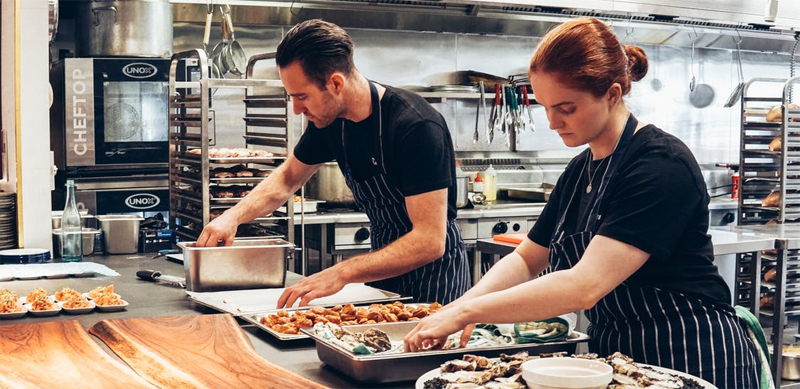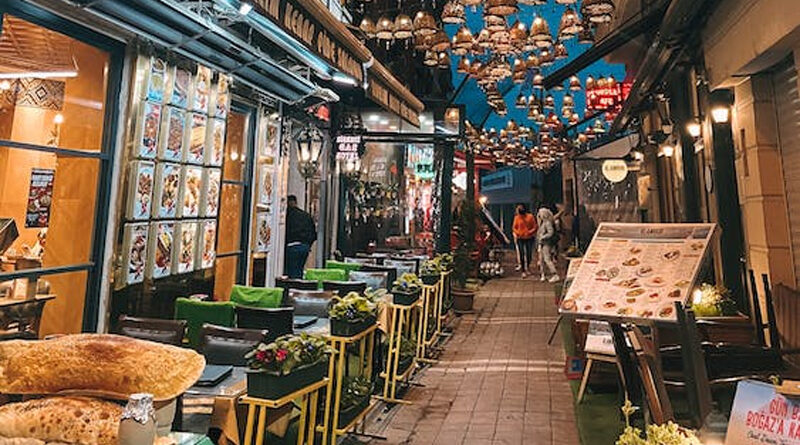10 TIPS TO HELP RESTAURANTS POST-PANDEMIC
Post pandemic, it’s a brave new world with new rules and processes, and navigating the new landscape is not easy. Amidst the myriad new local rules and regulations brought on by the pandemic, the very fabric of how we do business is changing too. What is a foodservice business owner to do with everything constantly in flux?
Having worked with 100s of restaurants and hospitality business across the world, here are my 10 most important areas for restaurant and other foodservice managers and owners to focus on.
 COMMUNICATE REGULARLY
COMMUNICATE REGULARLY
Perhaps the most frequent oversight from foodservice outlets is not sharing updates frequently enough. At its most basic, you need to broadcast in all available channels when you are open. Nothing is more frustrating for guests trying to figure out the new normal, which may include partial closures, reduced meal service, seating capacity controls, reduced number of locations and so on.
And when I say broadcast in all available channels, I do not just mean your social media accounts. Storefront or street signage is essential. So many people walk or drive by your place of business and have no idea about your social media sites. And don’t forget about email if you have a customer list. You can send out a quick email as often as you need with your current schedule. Your business will stay top of mind, and your customers will appreciate it.
Depending on how many mobile phone numbers you have from your customers, you could do an SMS broadcast, or even easier, create a WhatsApp group where you post regular updates. “We’re open this week Wednesday-Sunday 1700-2100, reservations required.” That type of thing.
MAKE IT EASY TO BOOK
Having a flexible, stress-free and easy-to-find booking policy will facilitate more direct bookings and encourage customers to rebook their reservation instead of outright cancelling. This also reinforces brand loyalty. Just make sure your policies are easy to find and clear. And if you expect an inordinate number of cancellations, keep a waiting list. Too much to do by yourself? Use a tool like Wisely or SimplySeated to help you stay organized to provide better customer service.
If your business is walk-in only and you do not use any software tools to help manage your waitlist, consider referring your overflow customers to other nearby businesses. I experienced this once and was nearly blown away. I appreciated that the restaurant was thinking of me and not just itself. I had a great experience at the place they referred me to, and I ended up coming back to the first restaurant on another day. It may sound counterintuitive. After all, why should you send business straight to your competitors? If your restaurant is full, what does it matter if your competitors get some business? A rising tide floats all boats.

KEEP IT SAFE
While lockdowns and restrictions have been easing across the world, many individuals are still wary and taking precautions when it comes to eating out. It is important to make all your guests and customers feel safe and comfortable in your venue. If you have not done so already, consider expanding your offering to include outdoor seating, weather permitting. Use every space you can, from pavements to parking areas.
Feeling creative? Some foodservice businesses have begun operating in yurts and igloos, where groups can enjoy the outdoors but still have some privacy and distance. For indoor service, make sure you still provide enough space between tables. It is tempting to squeeze in a few more tables to bring in additional revenue, but this will be off-putting to potential customers
While re-evaluating your space, consider alternative entrances and exits and do your best to keep them separate, always with clear signage. Speaking of which, always notify your guests of the measures taken to protect them with clear and visible signage, from hand sanitizer locations to mask regulations. Offer menus using QR codes for customers to access on their smartphones, or for customers without a smartphone, you can print paper menus that you later recycle after each use. As tempting as it may be, do not reuse paper menus between customers. Guests notice things like this.
FOCUS ON YOUR STAFF
As you well know, servers are crucial to the success of restaurants and hospitality venues as they have the power to serve not just a meal, but a memory. With this in mind, it is more important than ever to ensure your focus is on your servers. We are certainly aware of how hard it is to get waitstaff to come back to work, which is ironic, since plenty of others complain about not being able to find work. You can only offer meal service that corresponds to your server count. If you cannot reopen inside because of a lack of staff, then stick with take-away for now.
For new staff, there will be training on the new health and safety requirements. Make sure that your new or returning workers feel genuinely appreciated. Ensure that you pay living wages and be cautious not to overload your staff with extra responsibilities without rewarding them. If you are unable to offer more monetary compensation, provide different types of incentives with utter transparency.
Remind your team why it is important to work together and also of helping each other out during these times. Everyone copes differently with a crisis, and also in a crisis, families stick together. Work on succeeding together, which will benefit all parties.

MAKE A DIFFERENCE
As our sector faces uncertainty over staffing shortages, there is a hidden opportunity with an attractive benefit of hiring from underrepresented groups such as ex-offenders or those who have experienced homelessness. It not only allows for a diverse workforce and encourages teamwork, but there are plenty of studies that suggest that it can boost profits as well as draw consumers to your business.
If you are unable to do so, support a local NGO by adding a voluntary donation onto bills, volunteer working days in the community, or donate meals to those in need. And be transparent about how much is donated to which organisations and when. Not only will this make a positive difference to the causes you have chosen to support, but it will also improve brand perception and reputation, boost employee morale and engender team satisfaction.
BE PLANET-FRIENDLY
When it comes to your suppliers, proactively engage them in conversation. Explain to them that you want to see less packaging, especially from plastic, or that you want to source more locally. Be open and willing to adjust expectations on both sides, as this will heighten confidence and mitigate risk to your business. A collaborative and equal relationship is the only way to make progress, particularly around the facilitation of sustainable practices and goals. And remember, improvements you make to your supply chain may have marketing value to your customers.
Besides asking for reduced plastic in your delivered goods, consider diversifying your suppliers. If you can tap into local resources, even better because buying local has a much greater economic impact (some say 7x as much) than purchasing from bigger chains.
If current events have taught us anything, it is never to take anything for granted, not even your ability to operate. Count your resources and brainstorm backup business models in case of the unexpected. Can you launch different sales channels, like selling sauces or mixes? Can you partner with other local businesses? Consider leasing out underutilised space in your venue. Nothing should be dismissed.
Develop a worst case, realistic, and best case scenario financial projection (a potentially overlooked exercise that can really help give you an idea of where you are and could be). Then reduce spending where needed.
 SAY GOODBYE TO FOOD WASTE
SAY GOODBYE TO FOOD WASTE
Having worked in restaurants and with restaurant professionals around the world, it amazes me how much food waste still exists in restaurants and other foodservice outlets. Monitor where waste is being generated. Maybe it is leftover batch preparations, or items on dishes that guests don’t eat and end up as waste. If possible, reduce how much you prepare in batches and prepare only what will be used. And if you happen to run out of something, so be it. Improvise. Offer different portion sizes to adapt to your customers’ needs. In the case of buffets, serve food in individual glass jars or dishes, both for portion control and for safety.
If there is still waste, consider partnering with food waste management apps like Too Good To Go or Karma. It could be an additional source of income, even if small, and it is a win-win situation for both you and your customers, who will see a lot of value in being able to enjoy food from their favourite places at a reduced price. Encourage your dine-in customers to take home leftovers. Share meals with your staff at the end of the night, or donate them to organizations such as FareShare, PlanZheroes or the equivalent in your area.
GET GREENER
Work with your suppliers to reduce packaging and where possible, return it for reuse. Serve drinks from a beverage gun that uses refillable tanks or a soda machine instead of canned and bottled drinks poured into a glass. When feasible, buy your ingredients in bulk and use refillable containers.
Stop the use of all plastic, including cutlery, straws, sauce ramekins and takeaway packaging. Remember, porcelain, steel and glass can all be washed and sterilised. Encourage your customers to invest in their own reusable, portable cutlery for takeaway use when needed. If reducing packaging is not possible, switch to alternative materials that are easier on the planet, like bamboo, palm leaves, and even mushroom root and cornstarch. Motivate your guests to bring their own containers from home for takeaway orders and leftovers, providing a small incentive like discounting the cost of packaging from their total.
BUY LOCAL
There are so many sources of help, many of which go unused. Consider small business development centres, chambers of commerce, economic development offices and business incubators, all of which offer workshops and courses on many subjects like tax preparation, employee retention, sales, marketing, technology and even disaster preparedness. Such sources often offer consulting and can help you to find the right financing options for your business.
TAKE THE LEAD
Set up your business to be a leader through good examples. If possible, form a group or association and provide resources and guidance to industry members. Share stories across your social media channels. Invite your community to embrace these practices and share ideas of their own. And even share your learnings and new ways of doing business with other local businesses. Remember, a rising tide floats all boats.
You may have noticed that all of the above tips correspond to the triple bottom line, or People, Planet, Profit concept espoused by many responsible businesses today. Doing business today has a lot of moving parts – many more than in years past. And putting the 3Ps at the heart of your business will help ensure you thrive now and in the future. Hopefully, these tips will make it easier for you to navigate the new landscape, attract increasing numbers of customers and stay competitive in these trying times.
ABOUT THE AUTHOR
 ERIK WOLF, MA, CCTP, MCTP is recognized as the founder of the modern food tourism industry and the World Food Travel Association. He is a highly-sought speaker, thought leader, strategist and consultant, in the US, UK and abroad, on food and drink tourism issues, and has been featured in The New York Times, Newsweek and Forbes, and on CNN, Sky TV, the BBC, the Australian Broadcasting Corporation, PeterGreenberg.com, and other leading media outlets. He advises leading global brands such as World Travel Market, Absolut, American Express, Disney, Marriott and Royal Caribbean, and organizations such as UNESCO and UNWTO. His articles, research and books have been translated into dozens of languages.
ERIK WOLF, MA, CCTP, MCTP is recognized as the founder of the modern food tourism industry and the World Food Travel Association. He is a highly-sought speaker, thought leader, strategist and consultant, in the US, UK and abroad, on food and drink tourism issues, and has been featured in The New York Times, Newsweek and Forbes, and on CNN, Sky TV, the BBC, the Australian Broadcasting Corporation, PeterGreenberg.com, and other leading media outlets. He advises leading global brands such as World Travel Market, Absolut, American Express, Disney, Marriott and Royal Caribbean, and organizations such as UNESCO and UNWTO. His articles, research and books have been translated into dozens of languages.
instagram.com/worldfoodtravelassn
linkedin.com/company/world-food-travel-association
youtube.com/user/WorldFoodTravelAssoc

